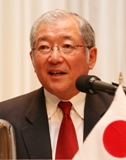��Firsthand Account on the Economic Development in the Middle East and its Future��
March 24, 2010
Mr. Takuma Hatano
Former Ambassador to the United Arab Emirates
Executive Vice President,
Toyo Engineering Corporation
 ��The Middle East economy now revolves around the Gulf nations (GCC), propelled by the huge market, business opportunity and economic power generated by the oil income. All Arab countries speak Arabic and majority of their population are Muslim. 22 nations joining the Arab League has 340 million populations with per capita income of ��4,800, a relatively poor region. When you look at the 6 GCC countries, their average GDP accounts for 60% of all Arab nations, with around ��30,000 per capita income, making them the world��s leading rich region.
��The Middle East economy now revolves around the Gulf nations (GCC), propelled by the huge market, business opportunity and economic power generated by the oil income. All Arab countries speak Arabic and majority of their population are Muslim. 22 nations joining the Arab League has 340 million populations with per capita income of ��4,800, a relatively poor region. When you look at the 6 GCC countries, their average GDP accounts for 60% of all Arab nations, with around ��30,000 per capita income, making them the world��s leading rich region.
��The royal families govern the six GCC countries with growing population of younger generation, and the maintenance of the political system is crucial. The monarchies, being the political leaders, are held accountable for social problems including unemployment. How to secure employment for young people is a pressing issue, especially in Saudi Arabia.
��UAE, one of the richest countries with per capita income exceeding ��100,000 dollars, faces different problems. In this newly rich county the majority of the workers are foreigners, and nurturing future leaders from the indigenous population is a major challenge.
��This GCC region historically has been the logistical hub for the East-West trade, a giant center where human, goods and money from India, China, Iran, Russia and African countries interchange. Commodities transported by land to India via the Silk Road were further transported westward to Europe through the 2 routes called the Sea Silk Road: the north route through the Persian Gulf and another route through the Red Sea. Traders generated wealth through barter at post towns called ��caravanserai.�� This long tradition of barter trade, entrenched in Arab values, definitely impeded the introduction of Western banking systems into the region.
��The 6 GCC countries all produce oil. Japan has long imported a quarter of its oil from Saudi Arabia, and another quarter from UAE. In other words, the national security of Japan depends on this region. IEA (International Energy Agency) predicts oil and gas will remain as principal energy sources for the coming 100 years. Demand for oil is estimated to grow by 1 million barrels per year, should global economy grow by 2-3 %. Besides Iraq, the 6 GCC countries, especially Saudi Arabia, are capable of responding to this ever growing oil demand.
��After the War, Saudi Arabia reached an agreement with the US to supply necessary amount of oil to Western countries in exchange to have the House of Saud protected. Their margins of supply are massive, reaching as much as 5 to 6 million barrels at one time. When the oil price fell, Saudi Arabia suffered from massive financial deficit and foreign credit. The oil price has risen during the last 5 years, allowing this country to repay its debts. Saudi Arabia also reduced its excessive production capacity, having less than 2 million barrels of production margin.
��The major oil producers determine supply levels and Saudi Arabia, as the principal supplier, has the power to set the oil price. The industrial world��s increasing reliance on oil has greatly enhanced the influence of the major oil producers. Their national finances are directly affected by the price of oil. Two years ago, when the oil price fell to 40 dollars, Saudi Arabia, serving its own financial interests, restricted oil production to force the price back to 60 dollars. It has since risen further, above expectations, to 70 dollars today.
��The oil price in 2009 was around 60 dollars, making the overall GCC current account surplus relatively small. Should oil price reach 100 dollars, as was the case in 2008, the current account surplus of GCC countries will exceed that of Japan. GCC is estimated to generate larger current account this year and this heralds a global shift in finances. The US is expected to have a current account deficit, whereas China, Japan and the GCC countries have current account surpluses.
��GCC has become a financial superpower. UAE has the world��s largest state-owned sovereign wealth fund called the Abu Dhabi Investment Authority. The World Bank estimates its financial assets to be between 500 billion dollars to 800 billion dollars. UAE invests its oil surplus funds into infrastructure setting for national development, including solar power generation. Saudi Arabia and Qatar invest into neighboring countries in the same manner. GCC makes various investments among its member countries.
��Dubai used to produce oil, but the country came to focus on utilizing real-estate to maintain its monarchy. They generated income by attracting foreign capital and stimulating real-estate demand. After the Lehman Shock in 2008, the real estate market in Dubai crashed, triggering the bubble economy to collapse. Average real estate prices are still dropping today, as they continue to adjust to the severe decline in the real-estate market. These price movements have regional implications since Dubai has become the hub in the Middle East.
��The last Sheikh Rashid constructed the world��s largest artificial harbor called Jebel Ali in Dubai, with a Free Zone where 6,000 companies from around the world established their office today. Dubai International Airport is a 10-minute-drive from this port, forming a unique new logistical and tourism model of ��Sea to Air��. I believe that Dubai will overcome the aftermath of the real estate bubble at some point and retain its function as the hub in the Middle East.